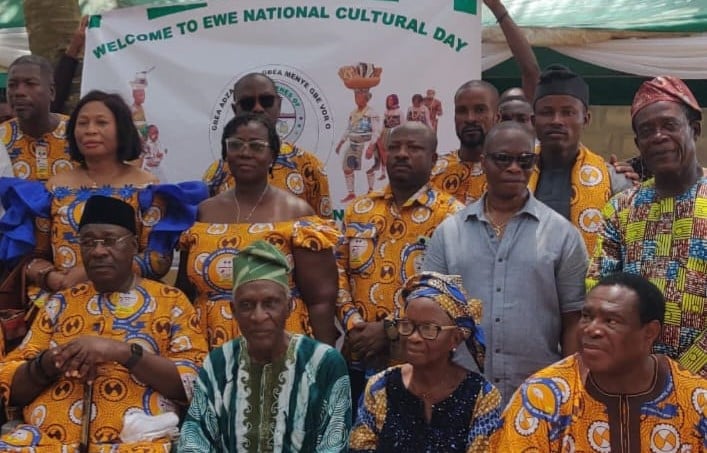Sitting from left: Leader of representatives of Ewes in Republic of Benin, Togo and Ghana, Mr Torgbui Agbelorm; Chairman of Yoruba Unity Forum and guest speaker, Archbishop Emeritus Ayo Ladigbolu; his wife, Afolake; and President, Ewe Indigenes of Nigeria, Herbert Ayeiadun, during the first Ewe National Cultural Day celebration, held on Friday, at Atisese village, Olomometa, in Ojo LGA of Lagos state.
Ayo Ladigbolu, archbishop emeritus of the Methodist Church Nigeria (MCN) and chairman of Yoruba Unity Forum, says the Ewe people originated from the old Oyo empire.
Speaking at the first Ewe national cultural day celebration in Lagos on Friday, Ladigbolu said the Yoruba roots of the Ewe people could be traced to the Old Oyo empire and the ancient city of Ile-Ife.
“The story of the Ewes is one of great historical significance, as they trace their roots back to the Old Oyo empire and the ancient city of Ile-Ife,” he said.
“It was under the leadership of Alaketu, a grandson of Oduduwa, that the Ewes embarked on a remarkable journey, migrating from Ile Ife during the twelfth century.
Advertisement
“The Ewe ethnic group of Nigeria stands as the descendants of those who journeyed from Ile Ife to various parts of modern West Africa before returning to establish their presence in Badagry and the coastal villages of Lagos State well before 1914.
“Their rich history and cultural contributions are a testament to their enduring legacy, as documented in the BRIEF HISTORY OF THE EWES OF NIGERIA submitted to the President, Commander-in-Chief of the Armed Forces, Federal Republic of Nigeria, in 2004.
“In addressing misconceptions, it is vital to recognize that the Ewe ethnic group is distinct from the ‘Agayin’ (Gἓnyi), both in historical and linguistic terms.
Advertisement
“The acculturation resulting from the Accra, Ada versus Akwamu war led to the settlement of a group of war refugees from Accra in Glidzi (Togo) with the assistance of the Anlo Ewes.
“The distinction between the Gᾱ and Ewe speakers, now colloquially referred to as ‘Aganyi,’ has been a point of misunderstanding, which we aim to clarify today.
“The Ewe communities on the coastline of Lagos State have always been indigenes of Badagry Kingdom in Lagos State and bonafide citizens of Nigeria (See Memo from His Majesty the Akran of Badagry to the Nigeria Comptroller-General of Immigration of 30/07/2004).
“The communities along the beach stretch from Seme border through Takwa Bay to Epe beaches. They have been involved in traditional and modern fishing occupations and the planting of coconut trees for centuries.
Advertisement
“It is on record that the oldest coconut tree in Nigeria may have been planted by the Ewe-speaking Nigerians.
“Yoruba language was the lingua franca of the Ajah and Ewe. They also wholeheartedly embraced the Yoruba traditional religion and its practices are warmly embraced by all their communities in spite of the existence of, and their adherence to Islam and Christianity.
“Yoruba traditional names such as Fagbeji, Amosu, Akapo, Agboade, Abiodun, Famuyiwa still remain Ewe names till date as inerasable symbols of their historical and cultural affinity to the Yoruba race.”
Advertisement
Add a comment







